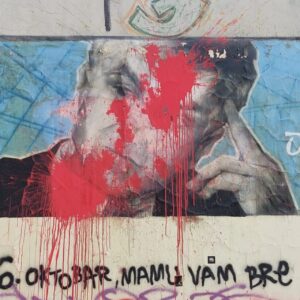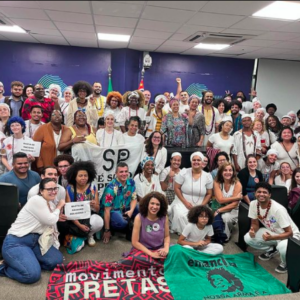Peru: The Battlefield of Memories
By Javier Lizarzaburu • 24 August 2021
There is no monument more contested in Lima than El Ojo que Llora (The Eye That Cries). Almost from the beginning it has been opposed and vandalized. A few years ago, the serenity and beauty of the area, in one of the main parks in the city, was compromised when the local authorities felt it necessary to fence it in to protect it from further violence. But that did not stop it. And during the highly divisive national elections of 2021 a now elected candidate for Congress, a former Navy admiral representing a notorious ultra-right group, called it a pro-terrorist monument.
The memorial was one of the recommendations in the final report of the Truth and Reconciliation Commission whose work, also highly contested, tried to look into the human rights abuses committed by the main maoist Shining Path group – considered responsible for the majority of crimes -, the military and other armed groups, that led to the killing of almost 70.000 Peruvians during the period of violent insurgency between 1980 and 2000. The collection of photographs under the title Yuyanapaq (To remember, in Quechua) is a deeply moving as well as shocking testimony of this period.
That nearly 80% of the victims were poor, Indigenous and Quechua-speaking people from the Andes is another painful image of this war. One of the most far-reaching conclusions in the Commission’s report pointed to structural racism and historic indifference toward Indigenous people as one of the factors that contributed to the death of such a large number of persons. This was also the first time an official document in the country mentioned racism in the context of violence and destruction.
It is no coincidence that most of the scholarly literature on the subject has been published in the last 20 years and that most identify Lima as the center of this harmful belief. For Peruvian historian Nelson Manrique, ethnic discrimination in the country was ‘legitimized by resorting to differences in language, religion, customs, clothing, ways of eating, worldview as a criterion of validation’ (2014, author’s translation). Alberto Flores Galindo, also a historian, identifies Lima, also the former capital of the Spanish colonies in South America, as ‘the centre of irradiation of the racist ideology.’ (2008, author’s translation).
Diverging interpretations of the conflict continue to exist. Conflicting memories resist the pass of time. But since the objective of this monument was to remember the victims of the conflict and since most of the victims were overwhelmingly from the Andes, and they were killed in the Andes, was Lima the right location?
Lima is my city of origin and the place where I grew up, and am well aware it is not an easy place. Its legacy of social exclusion is there to be seen and experienced in almost every corner. Many polls consistently show a large number of citizens, mostly with a migrant background, who feel discriminated against on a regular basis. On the other hand, the narratives that have been woven since the end of the conflict surely don´t help to make life in Lima any easier.
One of those narratives, popular among growing ultra-conservative groups, bluntly associates Indigenous people with potential terrorists – something that became evident during the 2021 elections; or the view that honours the role of the military while combatting Shining Path despite their part in human rights abuses against Indigenous people; or the one that places victimhood not on the people who died in the Andes but on Lima herself. It is difficult to measure to what extent these views are representative of most citizens, but they are certainly loud and forceful, and generally supported by the traditional media.
Besides the discussion around the location for this memorial, another consideration is time. Should it have taken longer to consider whether to build a memorial? In their study on memory and culture, Pennebaker and Gonzales (2009) refer that monuments tend to be built 20 to 30 years after the end of an event or conflict because that seems to correspond to when the process of healing starts or when ‘…society builds a consensus for the erection of a monument and an acknowledgement of the importance of the given collective memory.’ (p.186). If that were to apply here, we should be starting to discuss the possibility of a memorial only now.
However, this may not be a fixed rule. In 2005, a group of relatives of the people who were disappeared and of those who were killed opened their own museum of memory in the city of Ayacucho, the region that suffered the most during the conflict. Unlike the contested museum of memory in Lima, this one has become one of the most respected and visited places in Ayacucho. So, geographic and cultural proximity might be more relevant than timing, depending on the case.
The situation with The Eye that Cries does not seem to have easy answers for now. It could also be argued that precisely because of all that has been described above, Lima was indeed the right choice for the location in that it was deemed necessary to confront the city with an aspect of a reality that it finds difficult to understand or to accept. Lima, after all, is the capital of the country and the centre of power.
It could also be that having this monument in its midst allows for the conversation to be kept alive, however difficult it may sometimes get. What seems true at the moment is that reconciliation looks more like a moving target. The more one seems to get closer the more it moves away. And this, in itself, may not necessarily be a negative dynamic if a vision of common futures and political will are in place. That might be one way to start healing and being able to move forward.
—-
Sources
Bruce, J. (2008). Nos habíamos choleado tanto. Psicoanálisis y racismo.
Erll, A. (2008). Cultural memory studies: An introduction. In Cultural memory studies. pp. 1-18.
Flores Galindo, A. (2008). Buscando un inca: identidad y utopía en los Andes. En Autor, Obras completas.
Manrique, N. (2014). Racismo: una mala palabra. Acerca de un texto de Guillermo Rochabrún.
En Ministerio de Cultura, Racismo: ¿solo un juego de palabras? pp.49-54.
Pennebaker, J. & Gonzales, A. (2009). Making History: Social and Psychological Processes
Underlying Collective Memory. Memory in Mind and Culture. Ed: Pascal Boyer and James V. Wertsch. pp.171-193.
Wertsch, J. (2009) Collective Memory. Memory in Mind and Culture. Ed: Pascal Boyer and James V. Wertsch. pp.117-137.




